check engine light TOYOTA C-HR 2020 Owners Manual (in English)
[x] Cancel search | Manufacturer: TOYOTA, Model Year: 2020, Model line: C-HR, Model: TOYOTA C-HR 2020Pages: 536, PDF Size: 11.99 MB
Page 4 of 536

TABLE OF CONTENTS4
C-HR_OM_USA_OM10634U5-1. Using the air conditioning
system and defogger
Air conditioning system ..... 298
Heated steering wheel/ seat heaters .................... 306
5-2. Using the interior lights Interior lights list ................ 308• Interior lights ................. 309
• Personal lights .............. 310
5-3. Using the storage features
List of storage features...... 311 • Glove box...................... 312
• Console box .................. 312
• Bottle holders ................ 313
• Cup holders .................. 314
Luggage compartment features ........................... 315
5-4. Using the other interior features
Other interior features ....... 321 • Sun visors ..................... 321
• Vanity mirrors................ 321
• Power outlet .................. 322
• Assist grips ................... 323 6-1. Maintenance and care
Cleaning and protecting the vehicle exterior .......... 326
Cleaning and protecting the vehicle interior ........... 330
6-2. Maintenance Maintenance requirements ................... 333
General maintenance ........ 336
Emission inspection and maintenance (I/M)
programs ......................... 340
6-3. Do-it-yourself maintenance Do-it-yourself service precautions ...................... 341
Hood .................................. 344
Positioning a floor jack....... 346
Engine compartment ......... 347
Tires................................... 362
Tire inflation pressure ........ 372
Wheels............................... 376
Air conditioning filter .......... 379
Wireless remote control/electronic key
battery ............................. 383
Checking and replacing fuses ................................ 387
Headlight aim (vehicles with front fog lights) ......... 391
Light bulbs ......................... 393
5Interior features6Maintenance and care
Page 13 of 536
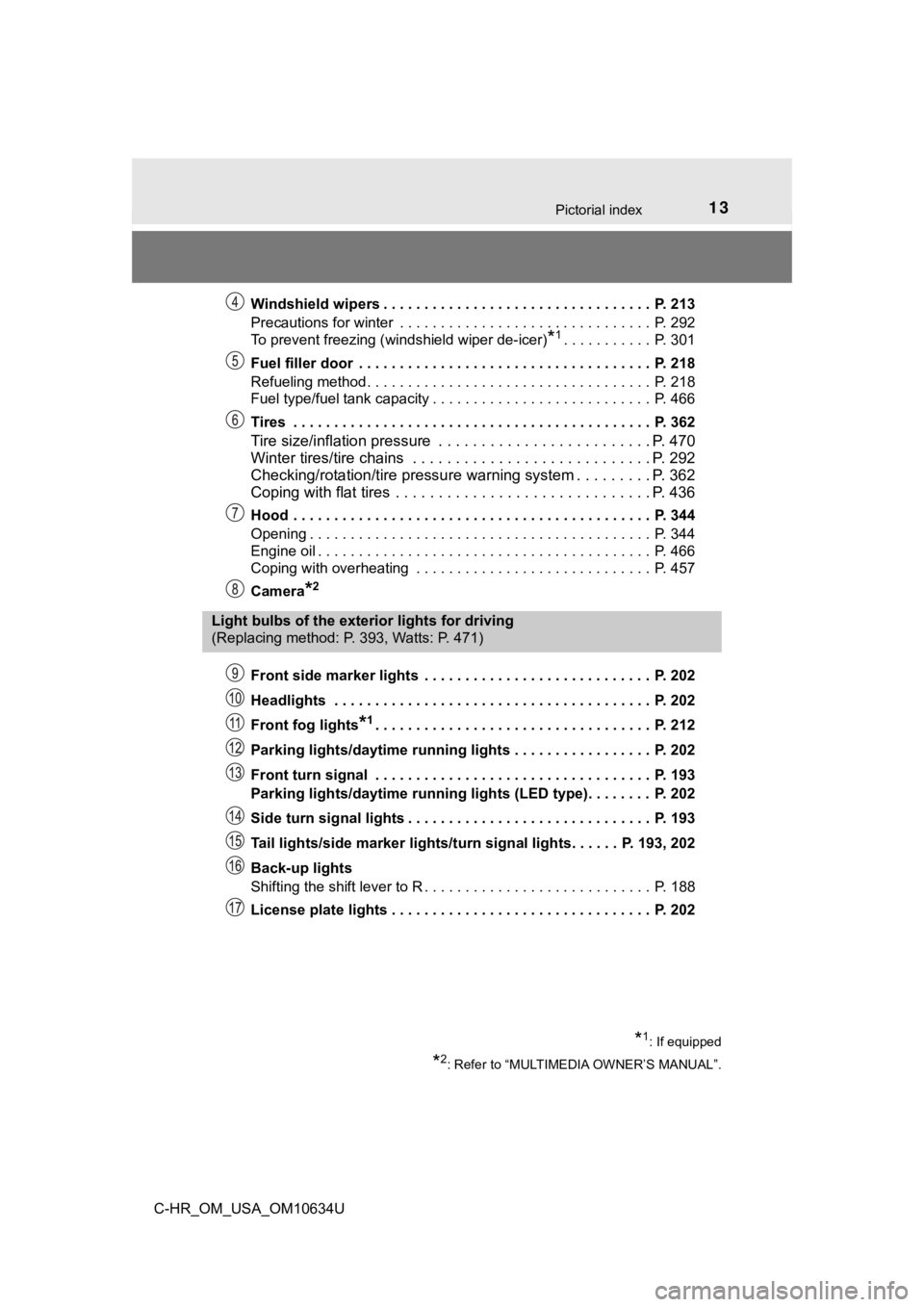
13Pictorial index
C-HR_OM_USA_OM10634UWindshield wipers . . . . . . . . . . . . . . . . . . . . . . . . . . . . . . . . . P. 213
Precautions for winter . . . . . . . . . . . . . . . . . . . . . . . . . . . . . . . P. 292
To prevent freezing (windshield wiper de-icer)
*1. . . . . . . . . . . P. 301
Fuel filler door . . . . . . . . . . . . . . . . . . . . . . . . . . . . . . . . . . . . P. 218
Refueling method . . . . . . . . . . . . . . . . . . . . . . . . . . . . . . . . . . . P. 218
Fuel type/fuel tank capacity . . . . . . . . . . . . . . . . . . . . . . . . . . . P. 466
Tires . . . . . . . . . . . . . . . . . . . . . . . . . . . . . . . . . . . . . . . . . . . . P. 362
Tire size/inflation pressure . . . . . . . . . . . . . . . . . . . . . . . . . P. 470
Winter tires/tire chains . . . . . . . . . . . . . . . . . . . . . . . . . . . . P. 292
Checking/rotation/tire pressur e warning system . . . . . . . . .P. 362
Coping with flat tires . . . . . . . . . . . . . . . . . . . . . . . . . . . . . . P. 436
Hood . . . . . . . . . . . . . . . . . . . . . . . . . . . . . . . . . . . . . . . . . . . . P. 344
Opening . . . . . . . . . . . . . . . . . . . . . . . . . . . . . . . . . . . . . . . . . . P. 344
Engine oil . . . . . . . . . . . . . . . . . . . . . . . . . . . . . . . . . . . . . . . . . P. 466
Coping with overheating . . . . . . . . . . . . . . . . . . . . . . . . . . . . . P. 457
Camera
*2
Front side marker lights . . . . . . . . . . . . . . . . . . . . . . . . . . . . P. 202
Headlights . . . . . . . . . . . . . . . . . . . . . . . . . . . . . . . . . . . . . . . P. 202
Front fog lights
*1. . . . . . . . . . . . . . . . . . . . . . . . . . . . . . . . . . P. 212
Parking lights/daytime running lights . . . . . . . . . . . . . . . . . P. 202
Front turn signal . . . . . . . . . . . . . . . . . . . . . . . . . . . . . . . . . . P. 193
Parking lights/daytime running lights (LED type). . . . . . . . P. 202
Side turn signal lights . . . . . . . . . . . . . . . . . . . . . . . . . . . . . . P. 193
Tail lights/side marker lights/turn signal lights. . . . . . P. 193, 202
Back-up lights
Shifting the shift lever to R . . . . . . . . . . . . . . . . . . . . . . . . . . . . P. 188
License plate lights . . . . . . . . . . . . . . . . . . . . . . . . . . . . . . . . P. 202
Light bulbs of the exterior lights for driving
(Replacing method: P. 393, Watts: P. 471)
*1: If equipped
*2: Refer to “MULTIMEDIA OWNER’S MANUAL”.
Page 53 of 536
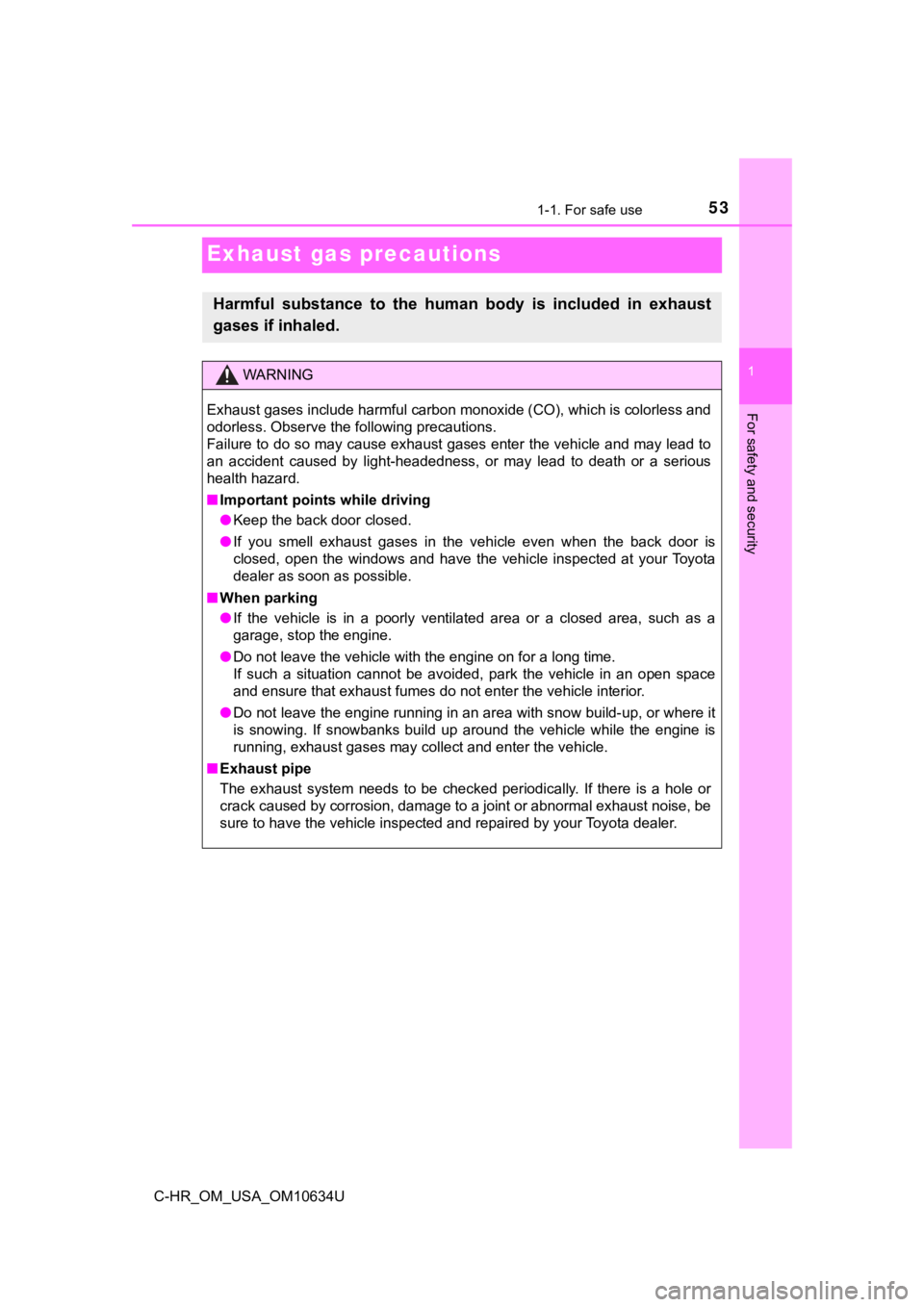
531-1. For safe use
1
For safety and security
C-HR_OM_USA_OM10634U
Exhaust gas precautions
Harmful substance to the human body is included in exhaust
gases if inhaled.
WARNING
Exhaust gases include harmful carbon monoxide (CO), which is colorless and
odorless. Observe the following precautions.
Failure to do so may cause exhaust gases enter the vehicle and may lead to
an accident caused by light-headedness, or may lead to death or a serious
health hazard.
■ Important points while driving
● Keep the back door closed.
● If you smell exhaust gases in the vehicle even when the back do or is
closed, open the windows and have the vehicle inspected at your Toyota
dealer as soon as possible.
■ When parking
● If the vehicle is in a poorly ventilated area or a closed area, such as a
garage, stop the engine.
● Do not leave the vehicle with the engine on for a long time.
If such a situation cannot be avoided, park the vehicle in an o pen space
and ensure that exhaust fumes do not enter the vehicle interior .
● Do not leave the engine running in an area with snow build-up, or where it
is snowing. If snowbanks build up around the vehicle while the engine is
running, exhaust gases may collect and enter the vehicle.
■ Exhaust pipe
The exhaust system needs to be checked periodically. If there is a hole or
crack caused by corrosion, damage to a joint or abnormal exhaust noise, be
sure to have the vehicle inspected and repaired by your Toyota dealer.
Page 88 of 536
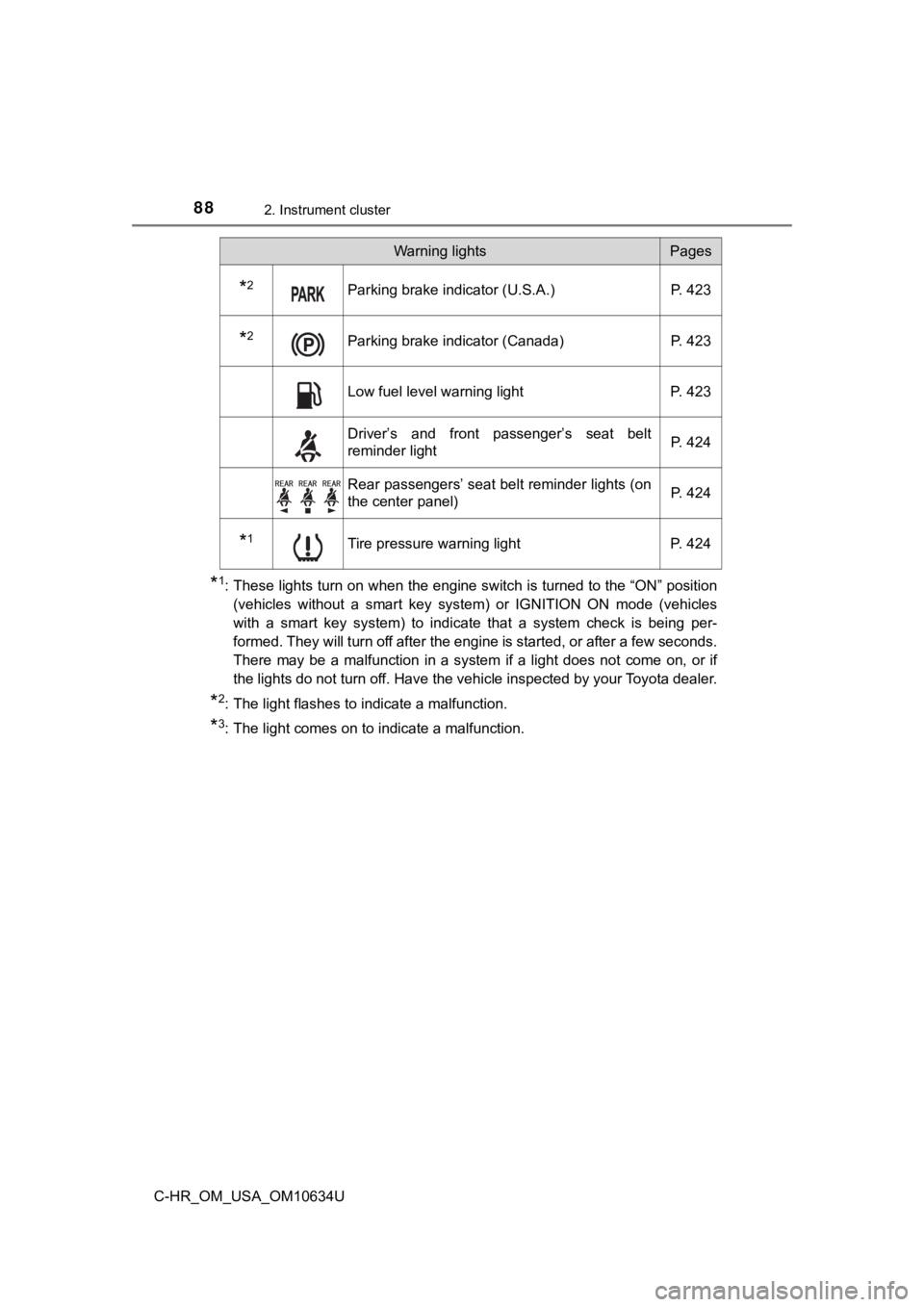
882. Instrument cluster
C-HR_OM_USA_OM10634U
*1: These lights turn on when the engine switch is turned to the “ON” position
(vehicles without a smart key system) or IGNITION ON mode (vehicles
with a smart key system) to indicate that a system check is being per-
formed. They will turn off after the engine is started, or after a few seconds.
There may be a malfunction in a system if a light does not come on, or if
the lights do not turn off. Have the vehicle inspected by your Toyota dealer.
*2: The light flashes to indicate a malfunction.
*3: The light comes on to indicate a malfunction.
*2Parking brake indicator (U.S.A.)P. 423
*2Parking brake indicator (Canada)P. 423
Low fuel level warning lightP. 423
Driver’s and front passenger’s seat belt
reminder light P. 424
Rear passengers’ seat belt reminder lights (on
the center panel)
P. 424
*1Tire pressure warning light
P. 424
Warning lightsPages
Page 90 of 536
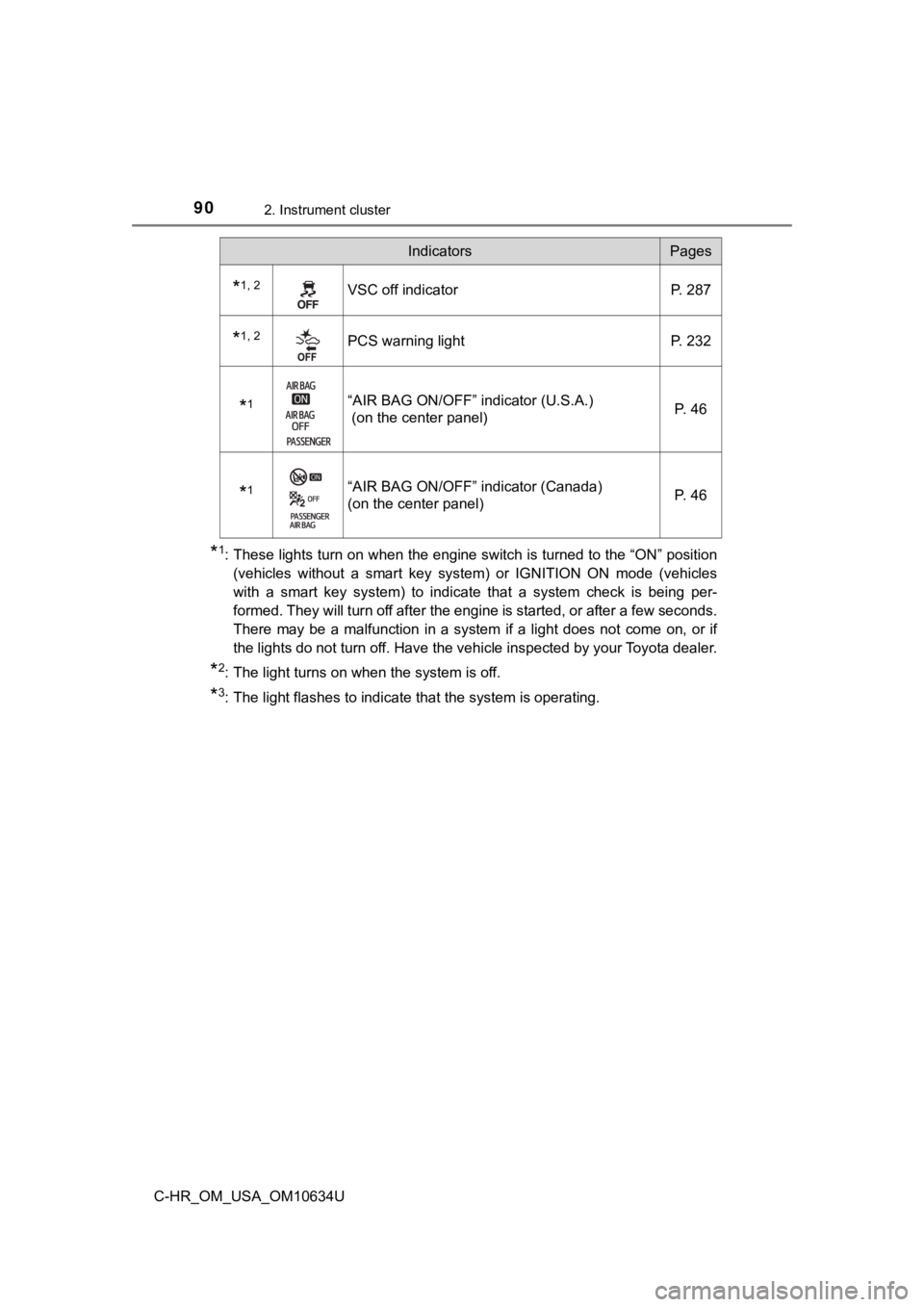
902. Instrument cluster
C-HR_OM_USA_OM10634U
*1: These lights turn on when the engine switch is turned to the “ON” position
(vehicles without a smart key system) or IGNITION ON mode (vehicles
with a smart key system) to indicate that a system check is being per-
formed. They will turn off after the engine is started, or after a few seconds.
There may be a malfunction in a system if a light does not come on, or if
the lights do not turn off. Have the vehicle inspected by your Toyota dealer.
*2: The light turns on when the system is off.
*3: The light flashes to indicate that the system is operating.
*1, 2VSC off indicatorP. 287
*1, 2PCS warning lightP. 232
*1“AIR BAG ON/OFF” indicator (U.S.A.)
(on the center panel) P. 46
*1“AIR BAG ON/OFF” indicator (Canada)
(on the center panel)P. 46
IndicatorsPages
Page 91 of 536
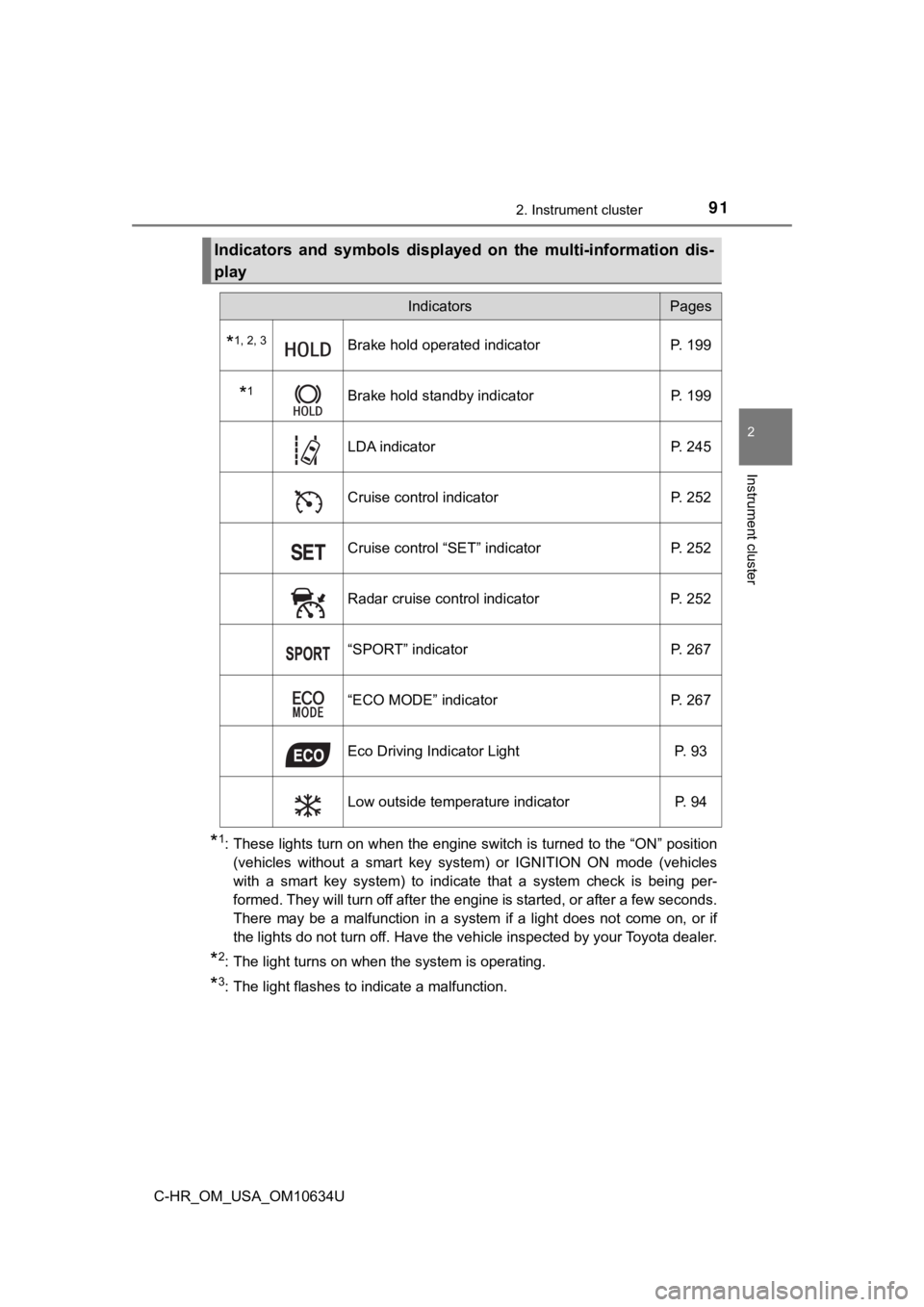
912. Instrument cluster
2
Instrument cluster
C-HR_OM_USA_OM10634U
*1: These lights turn on when the engine switch is turned to the “ON” position
(vehicles without a smart key system) or IGNITION ON mode (vehicles
with a smart key system) to indicate that a system check is being per-
formed. They will turn off after the engine is started, or after a few seconds.
There may be a malfunction in a system if a light does not come on, or if
the lights do not turn off. Have the vehicle inspected by your Toyota dealer.
*2: The light turns on when the system is operating.
*3: The light flashes to indicate a malfunction.
Indicators and symbols displayed on the multi-information dis-
play
IndicatorsPages
*1, 2, 3Brake hold operated indicator P. 199
*1Brake hold standby indicator P. 199
LDA indicator P. 245
Cruise control indicator P. 252
Cruise control “SET” indicator P. 252
Radar cruise control indicator P. 252
“SPORT” indicator P. 267
“ECO MODE” indicator P. 267
Eco Driving Indicator Light P. 93
Low outside temperature indicator P. 94
Page 96 of 536
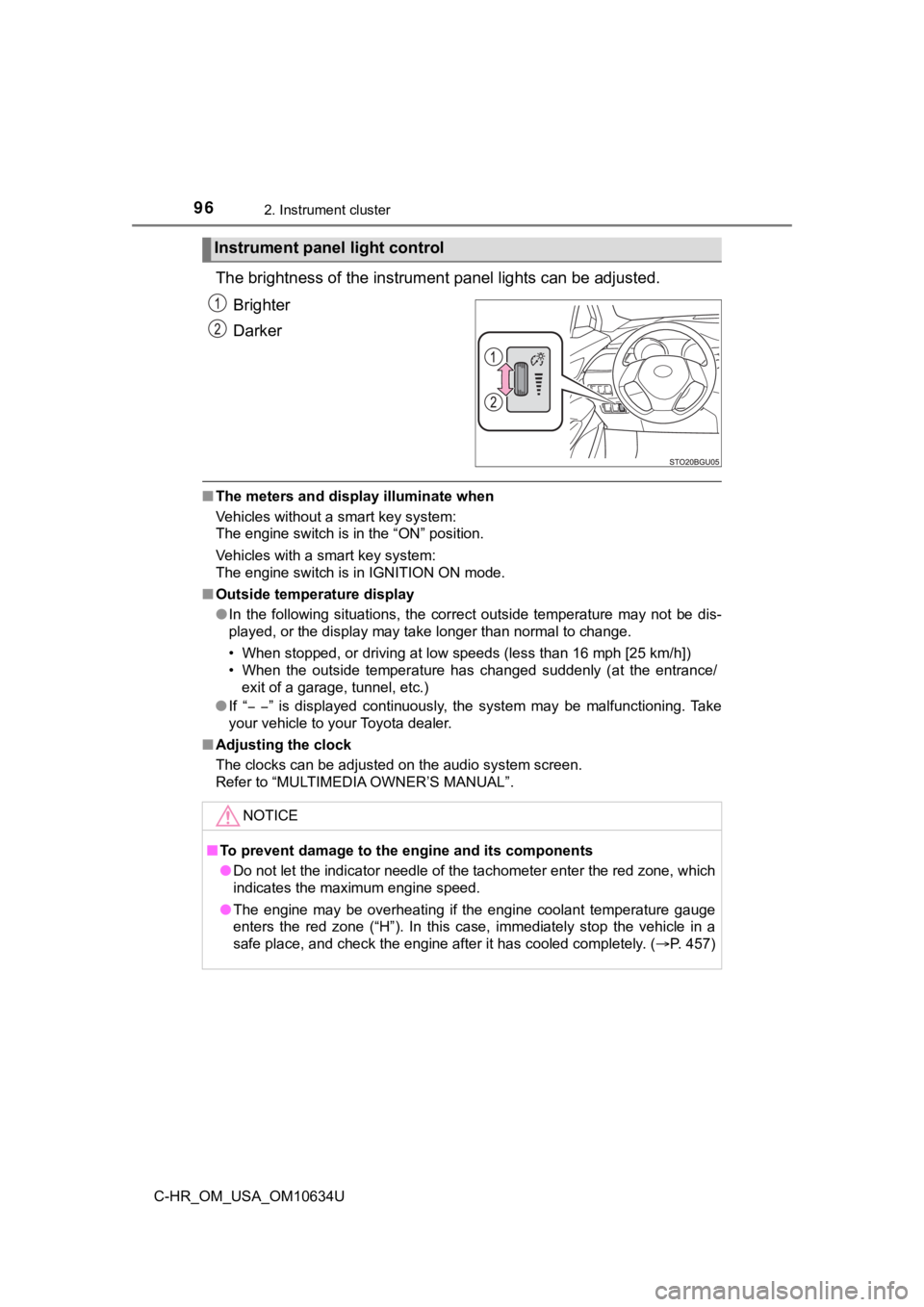
962. Instrument cluster
C-HR_OM_USA_OM10634U
The brightness of the instrument panel lights can be adjusted.
Brighter
Darker
■ The meters and display illuminate when
Vehicles without a smart key system:
The engine switch is in the “ON” position.
Vehicles with a smart key system:
The engine switch is in IGNITION ON mode.
■ Outside temperature display
●In the following situations, the correct outside temperature ma y not be dis-
played, or the display may take longer than normal to change.
• When stopped, or driving at low speeds (less than 16 mph [25 k m/h])
• When the outside temperature has changed suddenly (at the entr ance/
exit of a garage, tunnel, etc.)
● If “ ” is displayed continuously, the system may be malfunctioning. Ta k e
your vehicle to your Toyota dealer.
■ Adjusting the clock
The clocks can be adjusted on the audio system screen.
Refer to “MULTIMEDIA OWNER’S MANUAL”.
Instrument panel light control
NOTICE
■To prevent damage to the engine and its components
● Do not let the indicator needle of the tachometer enter the red zone, which
indicates the maximum engine speed.
● The engine may be overheating if the engine coolant temperature gauge
enters the red zone (“H”). In this case, immediately stop the v ehicle in a
safe place, and check the engine after it has cooled completely . (P. 457)
Page 166 of 536

1664-1. Before driving
C-HR_OM_USA_OM10634U
WARNING
Observe the following precautions.
Failure to do so may result in death or serious injury.
■When driving the vehicle
● Do not drive if you are unfamiliar with the location of the brake and accel-
erator pedals to avoid depressing the wrong pedal.
• Accidentally depressing the accelerator pedal instead of the b rake
pedal will result in sudden acceleration that may lead to an ac cident.
• When backing up, you may twist your body around, leading to a diffi-
culty in operating the pedals. Make sure to operate the pedals properly.
• Make sure to keep a correct driving posture even when moving t he
vehicle only slightly. This allows you to depress the brake and accelera-
tor pedals properly.
• Depress the brake pedal using your right foot. Depressing the brake
pedal using your left foot may delay response in an emergency, result-
ing in an accident.
● Do not drive the vehicle over or stop the vehicle near flammable materials.
The exhaust system and exhaust gases can be extremely hot. Thes e hot
parts may cause a fire if there is any flammable material nearby.
● During normal driving, do not turn off the engine. Turning the engine off
while driving will not cause loss of steering or braking contro l, but the
power assist to these systems will be lost. This will make it m ore difficult to
steer and brake, so you should pull over and stop the vehicle a s soon as it
is safe to do so.
However, in the event of an emergency, such as if it becomes im possible
to stop the vehicle in the normal way: P. 409
● Use engine braking (downshift) to maintain a safe speed when driving
down a steep hill.
Using the brakes continuously may cause the brakes to overheat and lose
effectiveness. ( P. 188)
● Do not adjust the display, the positions of the steering wheel, the seat, or
the inside or outside rear view mirrors while driving.
Doing so may result in a loss of vehicle control.
● Always check that all passengers’ arms, heads or other parts of their body
are not outside the vehicle.
● Do not drive in excess of the speed limit. Even if the legal sp eed limit per-
mits it, do not drive over 85 mph (140 km/h) unless your vehicl e has high-
speed capability tires. Driving over 85 mph (140 km/h) may resu lt in tire
failure, loss of control and possible injury. Be sure to consult a tire dealer
to determine whether the tires on your vehicle are high-speed c apability
tires or not before driving at such speeds.
Page 168 of 536

1684-1. Before driving
C-HR_OM_USA_OM10634U
WARNING
Observe the following precautions.
Failure to do so may result in death or serious injury.
■If you hear a squealing or scrap ing noise (brake pad wear limit indica-
tors)
Have the brake pads checked and replaced by your Toyota dealer as soon
as possible.
Rotor damage may result if the pads are not replaced when needed.
It is dangerous to drive the vehicle when the wear limits of the brake pads
and/or those of the brake discs are exceeded.
■ When the vehicle is stopped
● Do not race the engine.
If the vehicle is in any gear other than P or N, the vehicle may accelerate
suddenly and unexpectedly, causing an accident.
● In order to prevent accidents due to the vehicle rolling away, always keep
depressing the brake pedal while the engine is running, and app ly the
parking brake as necessary.
● If the vehicle is stopped on an incline, in order to prevent ac cidents caused
by the vehicle rolling forward or backward, always depress the brake pedal
and securely apply the parking brake as needed.
● Avoid revving or racing the engine.
Running the engine at high speed while the vehicle is stopped m ay cause
the exhaust system to overheat, which could result in a fire if combustible
material is nearby.
■ When the vehicle is parked
● Do not leave glasses, cigarette lighters, spray cans, or soft d rink cans in
the vehicle when it is in the sun.
Doing so may result in the following:
• Gas may leak from a cigarette lighter or spray can, and may le ad to a
fire.
• The temperature inside the vehicle may cause the plastic lenses and plastic material of glasses to deform or crack.
• Soft drink cans may fracture, causing the contents to spray ov er the
interior of the vehicle, and may also cause a short circuit in the vehicle’s
electrical components.
Page 187 of 536
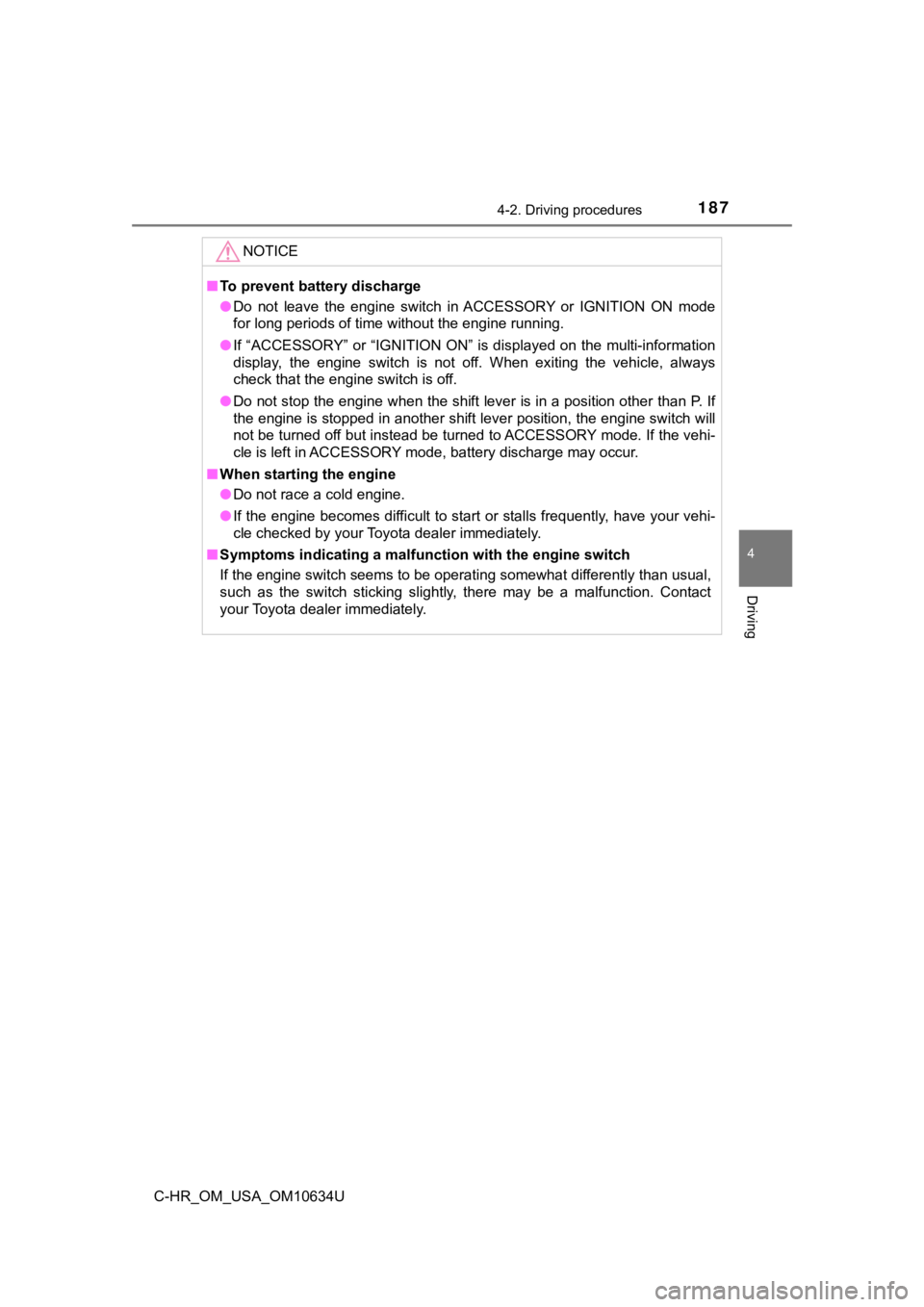
1874-2. Driving procedures
4
Driving
C-HR_OM_USA_OM10634U
NOTICE
■To prevent battery discharge
● Do not leave the engine switch in ACCESSORY or IGNITION ON mode
for long periods of time without the engine running.
● If “ACCESSORY” or “IGNITION ON” is displayed on the multi-infor mation
display, the engine switch is not off. When exiting the vehicle , always
check that the engine switch is off.
● Do not stop the engine when the shift lever is in a position ot her than P. If
the engine is stopped in another shift lever position, the engi ne switch will
not be turned off but instead be turned to ACCESSORY mode. If t he vehi-
cle is left in ACCESSORY mode, battery discharge may occur.
■ When starting the engine
● Do not race a cold engine.
● If the engine becomes difficult to start or stalls frequently, have your vehi-
cle checked by your Toyota dealer immediately.
■ Symptoms indicating a malf unction with the engine switch
If the engine switch seems to be operating somewhat differently than usual,
such as the switch sticking slightly, there may be a malfunctio n. Contact
your Toyota dealer immediately.